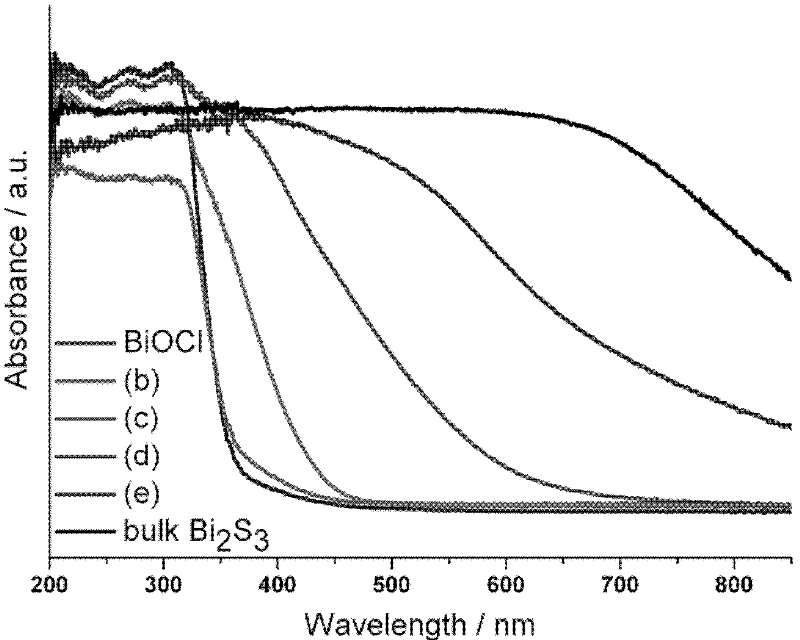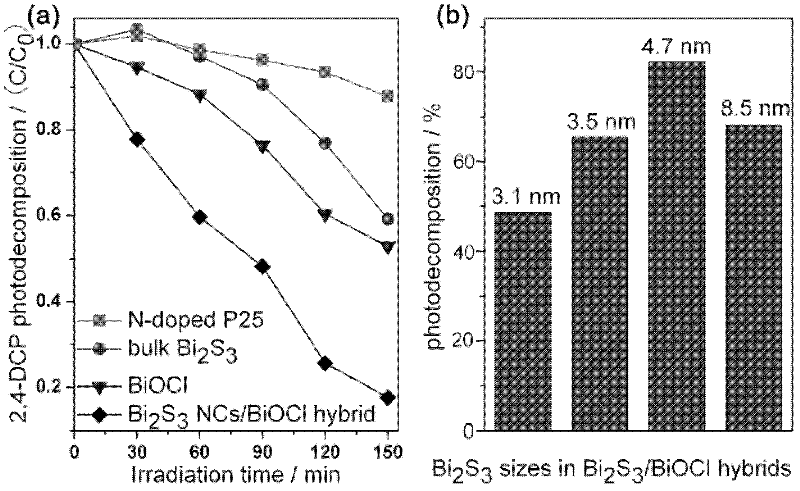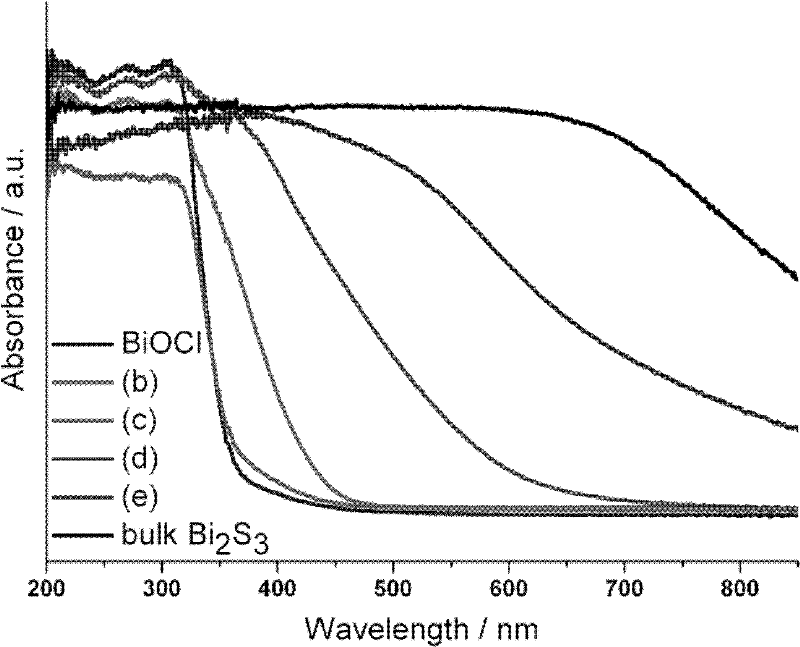Compound photocatalysis material with bismuth sulfide nano particles/bismuth oxychloride and preparation method thereof
A technology of composite photocatalysis and bismuth oxychloride, which is applied in chemical instruments and methods, physical/chemical process catalysts, chemical/physical processes, etc., can solve the problems of high carrier recombination rate and poor light absorption, and achieve low cost , low cost, good visible light absorption effect
- Summary
- Abstract
- Description
- Claims
- Application Information
AI Technical Summary
Problems solved by technology
Method used
Image
Examples
Embodiment 1
[0017] 0.97g of bismuth nitrate and 0.86g of 1-dodecyl-3-methylimidazole chloride were respectively dissolved in 40mL of ethylene glycol methyl ether, and magnetically stirred for 30 minutes to completely dissolve. The two solutions were then mixed and stirring was continued for 10 minutes before finally being transferred to a closed autoclave. Placed at 160°C for 2 hours to react. After cooling to room temperature, the product is collected, washed and vacuum-dried to obtain bismuth oxychloride microspheres with hierarchical structure.
[0018] (1) 0.261g bismuth oxychloride microspheres are added to the aqueous solution containing 0.075g thioacetamide, the molar ratio of bismuth oxychloride and thioacetamide is 1: 1, magnetic stirring is carried out at room temperature for 2-4 hours, and sulfur The sulfur ion produced by the decomposition of acetamide undergoes an ion exchange reaction with bismuth oxychloride to form a bismuth sulfide / bismuth oxychloride composite material....
Embodiment 2
[0020] (1) Dissolve 0.97g of bismuth nitrate and 0.86g of 1-dodecyl-3-methylimidazole chloride in 40mL of ethylene glycol methyl ether, and magnetically stir for 30 minutes to dissolve completely. The two solutions were then mixed and stirring was continued for 10 minutes before finally being transferred to a closed autoclave. Placed at 160°C for 2 hours to react. After cooling to room temperature, the product is collected, washed and vacuum-dried to obtain bismuth oxychloride microspheres with hierarchical structure.
[0021] (2) 0.261g bismuth oxychloride microspheres are added to the aqueous solution containing 0.076g thiourea, the molar ratio of bismuth oxychloride and thiourea is 1: 1, and magnetic stirring is carried out at room temperature for 2-4 hours, and thiourea decomposes to produce The ion exchange reaction between sulfur ion and bismuth oxychloride produces bismuth sulfide / bismuth oxychloride composite material.
Embodiment 3
[0023] (1) Dissolve 0.97g of bismuth nitrate and 0.86g of 1-dodecyl-3-methylimidazole chloride in 40mL of ethylene glycol methyl ether, and magnetically stir for 30 minutes to dissolve completely. The two solutions were then mixed and stirring was continued for 10 minutes before finally being transferred to a closed autoclave. Placed at 160°C for 2 hours to react. After cooling to room temperature, the product is collected, washed and vacuum-dried to obtain bismuth oxychloride microspheres with hierarchical structure.
[0024] (2) 0.261g bismuth oxychloride microspheres are added to the aqueous solution containing 0.121g cysteine, the molar ratio of bismuth oxychloride and cysteine is 1: 1, magnetic stirring is carried out at room temperature for 2-4 hours, half The sulfur ion produced by the decomposition of cystine undergoes an ion exchange reaction with bismuth oxychloride to form a bismuth sulfide / bismuth oxychloride composite material.
PUM
 Login to View More
Login to View More Abstract
Description
Claims
Application Information
 Login to View More
Login to View More - R&D
- Intellectual Property
- Life Sciences
- Materials
- Tech Scout
- Unparalleled Data Quality
- Higher Quality Content
- 60% Fewer Hallucinations
Browse by: Latest US Patents, China's latest patents, Technical Efficacy Thesaurus, Application Domain, Technology Topic, Popular Technical Reports.
© 2025 PatSnap. All rights reserved.Legal|Privacy policy|Modern Slavery Act Transparency Statement|Sitemap|About US| Contact US: help@patsnap.com



